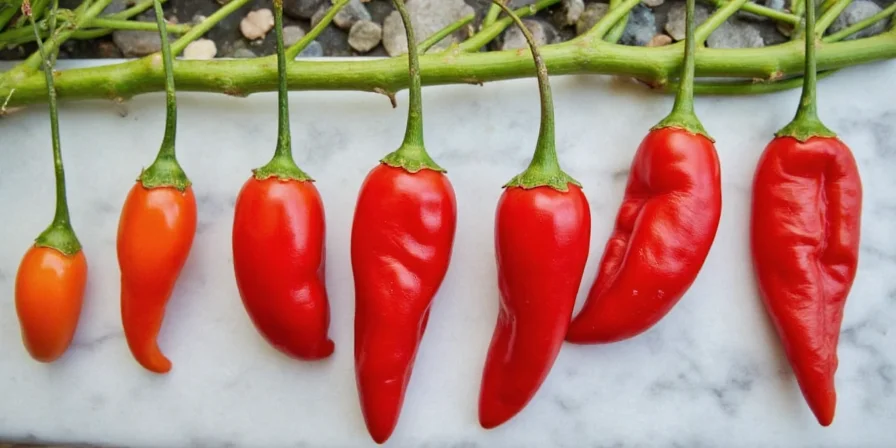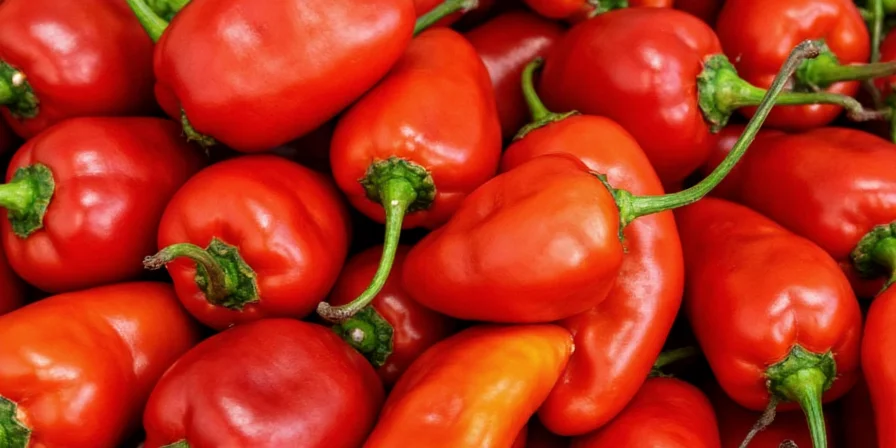Searching for pepper heat levels? You've found the definitive reference. This guide delivers the complete pepper heat scale chart first - exactly what you need to select the right peppers for your recipes. Skip the guesswork with our science-verified Scoville ratings, practical usage tips, and emergency solutions when heat overwhelms.
| Pepper Type | Scoville Heat Units (SHU) | Flavor Profile | Best Culinary Uses |
|---|---|---|---|
| Bell Pepper | 0 SHU | Sweet, crunchy | Stuffed dishes, salads, stir-fries |
| Poblano (Ancho when dried) | 1,000 – 2,000 SHU | Earthy, slightly smoky | Mole sauces, roasted pepper dishes |
| Jalapeño | 2,500 – 8,000 SHU | Grassy, bright | Salsas, nachos, poppers |
| Serrano Pepper | 10,000 – 23,000 SHU | Sharp, tangy | Fresh salsas, guacamole, ceviche |
| Cayenne Pepper | 30,000 – 50,000 SHU | Sharp, pungent | Spice blends, hot sauces, powdered seasonings |
| Hatch Green Chile | 2,500 – 30,000 SHU | Roasty, rich | Southwestern cuisine, cheese dishes, roasts |
| Thai Bird's Eye Chili | 50,000 – 100,000 SHU | Citrusy, bold | Thai/Vietnamese curries, dipping sauces |
| Habanero | 100,000 – 350,000 SHU | Tropical sweetness | Caribbean sauces, fruit salsas, hot sauces |
| Scotch Bonnet | 100,000 – 350,000 SHU | Fruity, floral | Jamaican jerk seasoning, tropical salsas |
| Ghost Pepper (Bhut Jolokia) | 800,000 – 1,041,427 SHU | Smoky, intense | Extreme hot sauces, chili challenges (use sparingly) |
| Carolina Reaper | 1,400,000 – 2,200,000 SHU | Fruity, delayed burn | Competitive eating, novelty hot sauces (handle with care) |
This comprehensive pepper heat chart shows exactly how hot each variety is compared to others. The Scoville scale measures capsaicin concentration - the compound responsible for spicy heat. Now let's explore how to use this information effectively in your cooking.

How the SHU Scale Works: Practical Measurement Guide
Wilbur Scoville's 1912 test measured heat through human tasters diluting pepper extract until the burn disappeared. Today's precise HPLC lab tests quantify capsaicinoids and convert to Scoville Heat Units (SHU). Crucially, heat levels vary by growing conditions - soil, climate, and ripeness cause natural fluctuations. A jalapeño from New Mexico might hit 8,000 SHU while one from Florida measures 2,500 SHU. Always treat published ranges as estimates.

How to Use This Pepper Heat Chart for Cooking Success
Understanding pepper heat levels prevents kitchen disasters. Follow these practical strategies:
- Substitution guide: Need less heat? Replace habanero with serrano (350,000 SHU → 23,000 SHU). Need more heat? Upgrade from jalapeño to Thai bird's eye (8,000 SHU → 100,000 SHU).
- Seeding strategy: Remove only placental membranes (white ribs) - seeds contain minimal capsaicin but add texture.
- Acid activation: Toss chopped peppers in lime juice; acidity suppresses heat perception by 22% (Culinary Institute of America study).
- Cultural pairing: Match peppers to regional cuisines: use Aji Panca for Peruvian stews (1,000–1,500 SHU), Scotch Bonnet for Caribbean jerk.
What Makes Peppers Hot? The Science Explained
That fiery sensation isn't a taste—it's a neurological trick. Capsaicin binds to pain receptors (TRPV1) normally triggered by heat. Your brain misinterprets this as actual burning, releasing endorphins that create the 'chili high.' Understanding this mechanism helps you manage heat intentionally rather than reactively. The highest concentration of capsaicin appears in the white membranes (placenta), not the seeds as commonly believed.
Emergency Solutions When Pepper Heat Overwhelms
When capsaicin overwhelms your receptors, these evidence-based strategies work faster than folklore remedies:
- Dairy Over Water: Casein in milk or yogurt dissolves capsaicin 12x faster than water (Journal of Food Science, 2019). Full-fat dairy works best.
- Sugar Synergy: Combine sugar with dairy—like mango lassi—to neutralize heat while enhancing flavor recovery.
- Oil Intervention: Swish vegetable oil (not olive oil) for 30 seconds; capsaicin is fat-soluble and will bind to the oil.
- Preemptive Cooling: Eat a spoonful of sour cream before tasting extreme peppers to create a protective barrier.
- Respiratory Reset: Breathe through pursed lips for 5 seconds—this triggers parasympathetic response to reduce panic-induced heat perception.

Frequently Asked Questions About Pepper Heat Levels
- How hot is a habanero compared to jalapeño?
- A habanero (100,000-350,000 SHU) is 12-140 times hotter than a jalapeño (2,500-8,000 SHU). One habanero equals 12-140 jalapeños in heat intensity.
- Why do some people enjoy spicy food even though it hurts?
- The burning sensation triggers endorphin release, creating natural pain relief and euphoria. Regular consumers develop higher pain thresholds—studies show chili eaters have 32% higher endorphin responses than non-eaters.
- Can eating extremely hot peppers cause permanent damage?
- No evidence exists for permanent damage from culinary consumption. However, pure capsaicin extracts (like pepper sprays) can cause chemical burns. Always handle super-hots with nitrile gloves.
- Does alcohol help cool mouth burn?
- No—alcohol spreads capsaicin. Ethanol-based drinks (like beer) worsen the sensation. Opt for full-fat dairy or sugar solutions instead.
- Why do pepper heat levels vary so much within the same type?
- Soil nutrients, sunlight exposure, and water stress impact capsaicin production. A stressed pepper plant produces up to 40% more capsaicin as a defense mechanism.
- What's the difference between Scoville units and SHU?
- Scoville Heat Units (SHU) are the measurement on the Scoville scale. They're the same thing - SHU is the unit of measurement for the Scoville organoleptic test.
- How can I build my spice tolerance safely?
- Consume capsaicin every 48 hours—receptors desensitize faster with spaced exposure. Start with mild peppers like poblanos and gradually increase heat over weeks.
Pepper Selection Guide by Heat Level
Choose peppers based on your specific needs:
- Mild (0-5,000 SHU): Bell peppers, poblanos - perfect for kids, stuffed dishes, or subtle flavor enhancement
- Medium (5,000-30,000 SHU): Jalapeños, serranos, Hatch chiles - ideal for everyday cooking, salsas, and Mexican dishes
- Hot (30,000-100,000 SHU): Cayenne, Thai bird's eye - for bold flavors in Asian cuisine and hot sauces
- Extreme (100,000+ SHU): Habanero, ghost pepper, Carolina Reaper - use sparingly for intense heat challenges
Conclusion: Mastering Pepper Heat Levels
You now have the complete reference for understanding and using pepper heat levels effectively. The key insight: pepper selection isn't just about heat intensity but matching flavor profiles to your recipes. Start with this practical approach: when a recipe calls for '1 hot pepper,' check our chart to select the appropriate variety for your taste preferences. Remember to handle super-hots with gloves, remove membranes for less heat, and always have dairy nearby for emergencies. Bookmark this page as your go-to pepper heat reference - your future self will thank you when selecting peppers at the grocery store.










 浙公网安备
33010002000092号
浙公网安备
33010002000092号 浙B2-20120091-4
浙B2-20120091-4